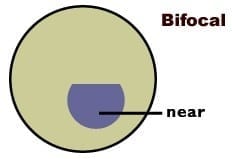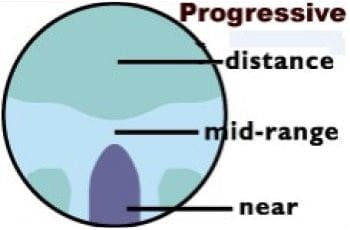Multifocal lenses are required due to presbyopia (aging eye). They enable the wearer to focus on both near and distance and, depending on the lens type, middle distances, without removing his or her spectacles.
There are three main kinds of multifocal lenses: bifocal, trifocal and progressive.

Presbyopia
The crystalline lens inside the human eye changes its shape to let us see clearly at different distances. As we get older the lens begins to lose its flexibility, which makes it increasingly more difficult and tiring for us to change our focus and to see close objects clearly. The difficulty in focusing generally becomes noticeable about the age of 40 to 45 years. Presbyopia can be corrected by spectacle lenses that restore our power to see at near range.
Reading spectacles are prescribed to help people see at near. These spectacles cannot be used to see in the distance, so the wearer will continually find it necessary to remove the reading spectacles when looking at people, viewing television or looking across the room or the street. While driving, it is necessary to constantly scan the road and the instrument panel and a single-vision reading lens will not permit this.
Bifocal lenses

The lower portion may be semi-circular, D-shaped, a narrow band or simply divided from the upper portion by a straight line. We can help you choose the kind of bifocal that will best suit your requirements.
If spectacles are already worn for distance vision, the onset of presbyopia means you will need either a second pair of spectacles for reading range or bifocal lenses incorporating prescriptions for both distance and near ranges.
For people who need near-range correction only, bifocals are still an excellent alternative to single vision lenses because they will avoid the inconvenience of removing the spectacles for distance vision.
Trifocal lenses

There are three portions to a trifocal lens. The top, which is usually the largest portion, is for distance; the middle section is for seeing at intermediate distances such as at arm’s length; and the lowest part is for reading and other close work.
The dividing lines between the three portions may be curved or straight, just as with bifocals. Trifocal lenses have these portions in different positions to cater for your particular needs.
Progressive lenses

Unlike a trifocal, progressive lenses do not have definite dividing lines between the different portions of the lens. Instead of distinct segments, there is a gentle change from distant to intermediate to near focus parts of the lens.
The wearer has an infinite number of focusing distances; the nearest one can get to having natural sight with prescription spectacles. All distances are sharp and clear.
Most people think that the progressive lenses look better than bifocals or trifocals because, like ordinary single vision lenses, there are no obvious lines across the lenses. Some people are reluctant to wear multifocal lenses because they associate them with older people. Progressives offer them the best of both worlds- the benefits of Multifocal lenses and a young appearance.
Another advantage of progressive lenses is that because there isn’t any sharp line dividing portions of the lens, there is no obstruction to vision and no image jump, which makes it safer to use stairs and escalators.
Adapting to progressive lenses often takes a few weeks. Distortion to the sides of the lenses when first wearing progressives is a common finding. Most people do adapt as with any new pair of glasses, but frame adjustment and fit, as well as accurate measurement of visual axes are critical to success with progressive lens wear.
Just as people’s circumstances are different, so their spectacle requirements are different. What is best for one may not suit another. Your optometrist will be happy to discuss your requirements with you and advise you on the most appropriate lens type for your lifestyle. You may find you require different lenses for different purposes. Progressive lens designs which suit office work, may not suit driving or recreation such as golf.
Related Information.
- Presbyopia
- Bifocals
Dr Ieuan H. Rees. (Optometrist)
Buck & Todd Optometrist
Located at 103 Alfred Street, Mackay, 4740.
